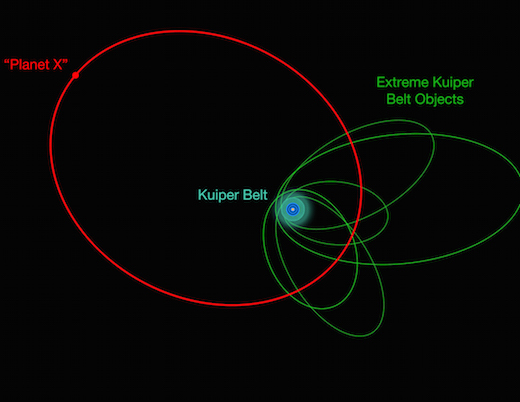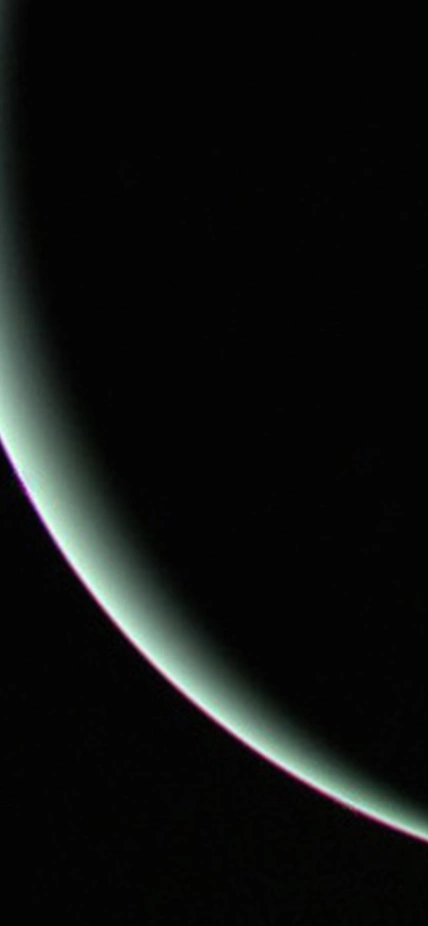In 1781, William Herschel discovered Uranus serendipitously while cataloging objects in the night sky. In fact, he first reported what was Uranus as a comet before further observations showed it was actually a very distant object. It was the first planet found with a telescope.

The view of Uranus recorded by Voyager 2 on January 25, 1986, as the spacecraft left the planet behind and set forth on the cruise to Neptune. (Credit: NASA)
French astronomer Alexis Bouvard noticed Uranus' orbital motion over the years was peculiar. He suggested that a more distant massive planet's gravity was perturbing Uranus. French mathematician Urbain Le Verrier used the basic laws of physics to predict where this new planet, if it existed, should be. In 1846 German astronomer Johann Galle found Neptune almost exactly where Le Verrier had predicted it to be. This was a major victory for the power of science to explain curious ongoings in the universe.
Later, in the early 20th century, American astronomer Percival Lowell had a great deal of money and decided to build Lowell Observatory in Flagstaff, Arizona. He believed Uranus' and Neptune's motions were showing signs of peculiarities and thus speculated another unknown planet still existed, beginning his search for what he called “Planet X” in 1906.

Lowell Observatory's 4.3-meter, $53 million Discovery Channel Telescope. (Credit: Lowell Observatory)
Clyde Tombaugh discovered Pluto in 1930 at Lowell Observatory. At first, it was thought Pluto was the legendary “Planet X”, but it was soon evident that Pluto was only about 2000 km in size, which is smaller than the Earth's moon, and not massive enough to affect Neptune's orbit. Later observations determined that Neptune's motion is as expected and no massive perturber was needed. However, our exploration of the outer solar system was only just beginning.
Some two thousand objects are known to orbit in the area near Pluto, now called the Kuiper Belt. The Kuiper Belt appears to have an edge around 48 AU, or 48 times the Sun-Earth distance, at which point the number of objects falls off sharply. It is the remnant of the original solar nebula that is too far from the Sun for material to have coalesced into a planet due to the large volume of space and low density of matter. In fact, it is so hard to form objects in the outer solar system that Uranus and Neptune likely didn't form where they are now, but were pushed out through interactions with Jupiter and Saturn.

This is an artist’s impression of a Kuiper Belt object, located on the outer rim of our solar system at a staggering distance of 4 billion miles from the Sun. (Credit: NASA, ESA, and G. Bacon (STScI))
The idea of there being a “Planet X” beyond the known planets has persisted to this day, but most of the reasoning for it to date have been whimsical or contrived. However in 2014, DTM astronomer Scott Sheppard and Chad Trujillo of the Gemini Observatory published the first strong evidence that a massive “Planet X” might just be real. They discovered an object with the most distant orbit ever observed, 2012 VP113, nicknamed Biden. Using this discovery, they noticed that it and the 12 most distant and extreme Kuiper Belt objects ever observed in our Solar System all had similarities in their orbits. This is unexpected, as Sheppard and Trujillo showed dynamically that the eccentric orbits of these distant small objects should be random if there are no major gravitational influences on them.

The red oval is the "Planet X" orbit prediction of Batygin and Brown (2016). The green ovals are the small extreme Kuiper Belt objects that Sheppard and Trujillo first used to identify "Planet X" through its gravitational interactions on the objects. The light blue dotted circle is the Kuiper Belt. The dark blue circles are the known giant planets. (Credit: Scott Sheppard, DTM)
Sheppard and Trujillo confirmed the clustering as real ruling out observational bias. They numerically simulated that a Super-Earth to mini-Neptune mass planet of 2 to 15 Earth masses in an orbit beyond about 200 AU up to an inclined orbit at some 1500 AU could create the orbital clustering in the extreme trans-Neptunian objects. This would put the unobserved planet on an orbit that took thousands to tens of thousands of years to go around the Sun once. In 2016, Konstantin Batygin and Michael Brown, astronomers at Caltech, confirmed the clustering of these extreme objects and showed mathematically that a Super-Earth to mini-Neptune on an eccentric, inclined orbit between 200 and 1500 AU could create the orbit similarities. Through a rigorous numerical simulation they found a set of rudimentary orbits that “Planet X” could have, being anti-aligned with the extreme trans-Neptunian objects. We are now in a similar situation that led to the discovery of Neptune in the mid-1800’s, where our knowledge about the laws of physics are being used to the extreme.
If “Planet X” exists as a Super-Earth to mini-Neptune at a few hundred AU as now thought, it would be too faint during most of its orbit to have been detected in any all-sky survey to date. Finding “Planet X” will likely require some of the biggest telescopes in the world searching large areas of the sky over many nights to faint depths. It is a daunting task, as time on large telescopes is not easy to come by. Our current technology is just on the edge of being able to discover this object. Still, “Planet X” will only be a fantasy until someone actually discovers it directly. Who knows, it may already be a point of light on some image somewhere, but just like Uranus, Neptune and Pluto, the recording will only be realized years after the object is actually identified.
The hunt goes on.
Written by Scott Sheppard, 28 January 2016
- - - - -
